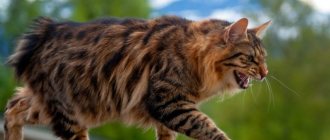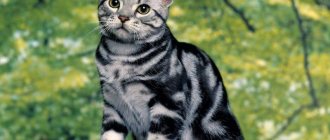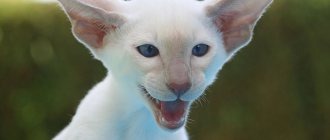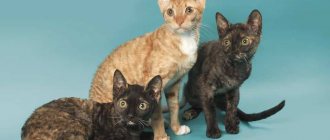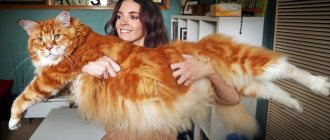There are currently about 600 million domestic cats living in the world. And less than one percent of them are considered purebred. Some varieties of cats are so unusual and unique that their cost can reach several hundred, thousand and tens of thousands of dollars.
First published: 07/06/2020
Photo: pixabay.com
Various breeds have appeared as a result of long breeding work or random genetic mutations. There are animal hybrids that emerged from crossing domestic cats with various species of wild cats. A breed acquires official status when it is registered and recognized by one of the felinological organizations.
The cost of a particular breed can be influenced by several factors:
- Rarity of representatives.
The rarer a breed is, the more valuable and expensive it is. - Class of purebred kittens.
Felinologists have defined three classes for purebred pets:
Pet
- a pet without breeding rights, with the lowest cost. - Breeding
- with the right to breed, its price increases significantly. - Show class
- meets all breed standards, intended for exhibition work. The most expensive.
Breed traits that are not found in most other cats.
Rating:
- Savannah
- Chausie
- Safari
- Khao-mani
- Toyger
- Bengal cat
- Peterbald
- American Curl
- Elf
- Serengeti
- Manx
- Russian blue
- Scottish fold
- British shorthair cat
- Maine Coon
- Persian
Serengeti
The breed is a hybrid. The basis was Bengal cats; Abyssinian, Oriental, European cats and Maine Coon were also used.
The cost of Serengeti kittens can reach $2000.
The breed is large, weight can reach 15 kg (in cats - up to 10 kg). The Serengeti has the longest legs and a long and muscular body. The color is spotted, with ring stripes on the tail. The ears are large, as long as the muzzle or slightly less. The eyes are large and round, set close together, always rich in color and in harmony with the color.
The Serengeti is characterized by activity, curiosity and a love of outdoor games. The cat does not tolerate loneliness and lack of attention well; it may not get along with other pets.
Peterbald
Peterbald
The elegant and charismatic Peterbald, also known as the St. Petersburg Sphynx, is a Russian breed of hairless or partially hairless cat. The residual fur of representatives of this tribe can be velvety or coarse, similar to a two-week stubbled male beard. The first Peterbald was born in 1994, as a result of the mating of an elite Don Sphynx and an Oriental cat, a world champion. In the 90s, club breeders began to export Peterbalds abroad.
Representatives of this breed boast a muscular constitution, but, like all Orientals, they are incredibly graceful. They are distinguished by an elongated and narrow muzzle with a noble straight profile, ears like a bat, and almond-shaped eyes of green or bright blue. Peterbalds are very affectionate, intelligent, incredibly curious and sneaky, it is impossible to hide a treat from them. The owners of these cats need to remember that their skin is very sensitive and susceptible to sunburn. It is necessary to ensure that the Peterbald is not exposed to the open sky for a long time in clear weather. Kittens with an elite pedigree are sold in Russia for $1000-1300; abroad their cost can reach up to $5000.
Peterbald
Russian blue cat
Russian blue cat
Russian Blues captivate with their brilliant green eyes and blue-gray fur that shimmers with silver. Perky and smart cats are devoted to their owners and know how to adapt to their mood. True, sometimes they can be stubborn and love freedom, and show dissatisfaction when a stranger appears. It is interesting that, being in any mood, these beauties look content and happy. This is all thanks to the fact that the outline of their mouth resembles a slight smile.
Russian Blues are also called Archangel cats, as they became famous thanks to the kittens from Arkhangelsk. They were brought from Russia by British breeder Karen Cox. In 1875 they were exhibited at a cat show at London's Crystal Palace. They say that Russian blue cats bring prosperity and happiness to the home. But the cost of the talisman is high: from $400 to $2000.
Russian blue cat
Bengal cat
How's the water?
Despite their exotic and somewhat wild appearance, Bengal cats are wonderful pets. The history of this breed can be traced back to the 60s of the last century, when American Jane Mill, a specialist in the field of genetics, crossed a wild leopard cat with a domestic cat. The breed received official recognition in 1983. The Bengal is distinguished by its muscular build, thick silky fur with a deep shine and spotted color. This is the only breed of domestic cat that has markings in the form of a rosette - a kind of marking on the fur of wild animals that helps them camouflage.
Long, lean Bengal cats are incredibly impressive and confident. They are very smart, inquisitive and love action. The wild nature of Bengals is manifested in their ineradicable desire to hunt. Even aquarium fish can become victims of cats. Energetic and curious, they love to swing from chandeliers, play with light switches, splash around in the bathtub, have fun opening latches on doors - in general, get up to absolutely amazing antics. The energy of these animals should be directed in a peaceful direction, providing them with physical activity. But, in general, Bengal cats are quite social. They are attached to all household members, sociable, ready to tolerate being “squeezed”, and demonstrate a friendly attitude towards other pets and children.
You can become the owner of a Bengal cat by paying $2000-5000. The cost of kittens with a particularly rare color and outstanding pedigree reaches $20,000.
Bengal cat
Toyger
These cats resemble toy tigers.
A kitten can cost $15,000.
The breed is short-haired. The main background is brown, with dark stripes on the back, chest, belly, paws and tail. The fur is plush, the presence of sideburns on the sides of the muzzle is appreciated. The eyes are small, the eyelids droop slightly. The ears are slightly rounded. Not all organizations have yet recognized the breed.
Munchkin
This breed is very unusual. Due to their appearance, such cats are sometimes called dachshunds.
The cost of kittens can reach $4000.
The Munchkin has a body of medium length, but its paws are 2-3 times shorter than usual. The head is proportional to the body, the contour is rounded, high cheekbones protrude. The ears are medium or large, proportional to the head, have a wide base, and the tips are slightly rounded. Almond-shaped eyes are large or medium, the color is not related to color. The coat can be short or long.
The munchkin does not stand on its hind legs, but sits on its seat, resting its tail. The cat can spend a long time in this position; it looks like a kangaroo.
Chausie
Chausie
Chausie, the obstinate descendants of the wild swamp lynx and the Abyssinian domestic cat, were recognized as a special breed in the 90s of the 20th century. This proud creature with a rather muscular body, long legs, a neat face and a serious look of golden yellow or amber eyes is an excellent companion for those who love cats with character and intelligence. But it’s difficult to keep an extravagant beauty in an apartment - she needs space. Chausies are very active, they love to jump, climb heights, explore the territory and hunt. They, like dogs, are perfectly trainable and have amazing intuition, feeling what the owner needs at a certain moment.
Chausies are sociable cats. They like to play with children, they are friends with their relatives, and do not mind the company of dogs. These wayward exotics quickly become attached to their owners, but they are not particularly enthusiastic about gentle hugs. Chausies of generations A and B, hybrids of the first and second generations from crossed wild and domestic cats, have an impressive set of pronounced predatory habits. Representatives of more distant generations C and SBT can already lay claim to the title of “pet”. The cost of purebred Chausie can reach $10,000.
Chausie
Ragdoll girl, 130 thousand rubles
Another breeder, from Vladivostok, offers to buy an eight-month-old Ragdoll girl for almost the same money, noting that she is vaccinated and has all the documents confirming her thoroughbred.
Cat Darksummer Apple Pie. Photo: courtesy of Bary Pride Ragdoll Kennel
The character of the Ragdoll fully corresponds to the name of the breed (translated as “rag doll”), they are calm and kind. Constant muscle relaxation makes them surprisingly pliable, and they simply hang on a person’s hands. However, this feature is also the Achilles heel of ragdolls: they, unlike other cats, do not know how to land on all fours and can get hurt if they fall even from a small height.
Silver-shaded chinchilla, 70 thousand rubles
An eleven-month-old British chinchilla of a silver-shaded color is sold there by a breeder from Ussuriysk, who has provided World Cat Federation (WCF) documentation for the cat. The seller also undertakes to help in delivering the animal, but at the buyer’s expense. Delivery to a transport company that will send a Briton to another region will cost an additional 9 thousand rubles.
Silver shaded cat Ice Cream Arte Vita. Photo: courtesy of the nursery of British cats of precious colors Arte Vita
British Shorthair cats received their silver-shaded color from Persians. All British dogs of this color are usually called chinchillas, which is not very correct. A real chinchilla is a silver chinchilla cat. Silver-shaded Britons are noticeably darker than chinchillas. In addition, their ears, legs and tail are more intensely colored (in chinchillas these parts are white). According to the standard, the eyes of silver shades can be green and yellow.
Golden ticked chinchilla, 50 thousand rubles
The top 10 opens with a variety of British shorthair cat - a five-month-old chinchilla of golden ticked color, an advertisement for the sale of which was published on Avito. The owner is ready to document the cat’s birth and vaccination status and promises to help with delivery.
Golden chinchilla at the exhibition on March 6, 2016. Photo: RIA PrimaMedia
The chinchilla breed appeared as a result of crossing a British and a Persian. According to standards, a golden cat should only have green eyes. The color of the coat itself is also important, and there should be no patterns on it. The golden ticked color is characterized by alternating zones of black and light brown on each hair. The ideal of this color is considered to be the color of the Abyssinian cat (which can be seen below).
Khao-mani
Khao-mani
Having a centuries-old pedigree, the favorites of the monarchs of Thailand are still considered elite cats today. Kao-mani (“white gem”) are one of the rarest breeds in the cat world. They have long been popular in Thailand, but appeared on the international scene only about 10 years ago. These muscular cats are active, intelligent, sociable and, not surprisingly for royal favorites, very capricious and capricious.
Kao-mani is captivated by its thick, tight-fitting snow-white fur and the penetrating gaze of its almond-shaped blue or golden eyes. If in ancient times it was allowed to keep and breed kao-mani exclusively at the royal court, today anyone who is willing to part with $1800-3500 can become the owner of this mustachioed beauty. The most valuable are the kao-mani, which have one eye blue and the other golden. In Thailand, where they believe that these cats bring bliss and healing to their owners, their cost can reach $10,000. This amount will have to be paid for a kao-mani with rare features, different eyes and “miraculous abilities” to cure diseases.
Persian cat
Persian cat
It is generally accepted that the ancestors of these imposing beauties were brought to the European continent from Persia (modern Iran), although there is historical evidence that the breed existed before our era. The ranks of fans of Persian cats are not thinning. People love them for their calm, easy-going character, intelligence, friendliness and, of course, for their unmatched appearance. Persians have luxurious long hair, a cute “Pekingese” face with expressive eyes, which, depending on the color of the animal, can be green, copper-orange or blue. Particularly delightful are white Persian cats with gentle pansies.
Persians love comfort and their owners, they are ready to be friends with other pets, even birds, because the breed has lost its hunting skills. Cats will not frantically rush around the room when they are in a playful mood, tear off furniture with their claws, or jump on high surfaces. They prefer to bask endlessly in their master's bed, which is why they are called sofa cats. However, these couch potatoes can be quite interested in balls, artificial mice and other toys. It is important to carefully and regularly care for the royal “fur coat” of the Persians, otherwise it will be spoiled by tangles. Prices for Persian cats start at $500 and can reach up to $5,000 if the chosen fluffy specimen is the offspring of champion parents.
Persian cat
Sphinx
One of the controversial breeds - some people like it crazy, while others find the appearance of the animals unpleasant.
The cost of kittens reaches $3000.
Sphynxes have no fur - this is a consequence of a natural mutation. The skin is folded, the ears are very large with a wide base, open and erect. The arches of the cheekbones are rounded and strongly pronounced. The eyes are large and lemon-shaped.
Sphinxes are distinguished by intelligence and playfulness, they become strongly attached to their owners and get along well with other animals. Health problems are not typical for the breed. The disadvantage is the need for special care for the skin, since due to the lack of wool it quickly becomes dirty.
Factors influencing the cost of the breed
Among the most expensive cats there are both common and rare breeds. Popularity is not a key factor in determining value. The following factors are more significant when setting prices:
- Exoticism . The most expensive existing breeds are hybrids with wild relatives: servals, African jungle cats. Their advantage is their unique beauty, similarity in appearance to their wild ancestors. A pet that looks like a serval or a lynx is a desirable and fashionable acquisition for the rich and celebrities.
- Breed class. Kittens in nurseries are divided into 3 categories according to breed standards. The most expensive pets participating in exhibitions belong to the show class. Breeding class kittens are in the middle price category and can be used for breeding. And pet-class pets, which do not fully comply with the breed standard, but do not have deviations or pathologies, become wonderful companions.
- Pedigree . Kittens born to champion parents, participants and winners of many exhibitions, are more expensive than offspring born to ordinary purebred cats.
- Non-standard appearance . Within a breed, kittens are sometimes born that have specific traits. This is not always considered a breed defect. Some non-standard kittens look so beautiful and original that those who want to buy them spare no expense.
- Unique color . Sometimes kittens appear in a litter, the colors of which differ from the breed standard, but do not spoil, but decorate their appearance. For example, when Siamese parents had offspring with white “socks” and a muzzle, a beautiful and rather expensive snowshoe breed arose. There are queues for kittens with original colors, because everyone wants their pet to be special. This determines the pricing policy.
Turkish van
One of the oldest domestic breeds.
The cost of kittens starts from $3000.
The breed is semi-longhaired. The classic colors are red and white and creamy white. The physique is average, the muscles are pronounced. The head has the shape of a truncated triangle, the ears are large with a wide base, the tips are slightly rounded. The large eyes are oval-shaped, set slightly obliquely, and can be light amber, blue or of different colors with pink edging.
The Turkish Van is energetic and sociable, with a melodious voice. The cat loves to run and jump, is not afraid of water at all and loves to swim.
No. 13. British Shorthair
The real pride of Foggy Albion. A well-known breed of medium-sized cats with very soft, elastic fur. Received official recognition in 1984. The color of the "British" can be different. Popular options are chocolate, gray-silver, bluish, lilac. The muzzle is slightly round, which is why the appearance of the animals seems doll-like and very pretty.
The character of cats is primordially British - restrained, calm, balanced, with a pronounced sense of self-esteem. They do not like to sit on their hands, accompanying this process with dissatisfied meows. Representatives of the breed do not need the constant presence of people - they like solitude more than noisy company. If the British want to play, they will do everything to ensure that people comply with their request.
The price of a purebred British Shorthair kitten from a breeder can reach 1.5 thousand dollars.
American Curl
American Curl
Representatives of this overseas breed of short-haired and semi-long-haired cats are touchingly gentle and restless. They captivate with their lovely silky fur and expressive eyes, but their main highlight is their ears that curl back and look like horns. The Curl's origins can be traced back to a stray black cat with long hair and funny ears who was adopted by California couple Joe and Grace Ruga in 1981. Shulamith, as the owners named the cat, became the ancestor of the breed that is popular today.
The amazing shape of the American Curl's ears is the result of a random mutation. Interestingly, the cubs are born with straight ears, and they begin to curl up in the first ten days of their life. Curls are very affectionate, intelligent, and playful. They love to communicate with people and are ready to be friends with all the animals in the house. American Curl babies cost between $1,000 and $3,000.
American Curl
No. 1. Savannah
The most valuable breed of pets was bred artificially by selecting a domestic cat and a serval. Savannah breeding started in the 80s of the last century. The first offspring appeared in 1986.
Adult parameters:
- height – 60 cm;
- weight – 15 kg.
Distinctive characteristics:
- slender body;
- long paws;
- thick coat;
- large, bowl-shaped ears.
Savannah cats boast an easygoing disposition, developed intelligence, and high activity. They quickly get used to people and their new habitat. To live a full life, they need space to play, move and walk. They love to walk outside and take water treatments. They get along well with dogs and birds, but cannot tolerate rodents.
The price depends on gender and class, ranging from 5 to 25 thousand dollars.
Scottish Fold (Scottish Fold)
A distinctive feature of the breed are small ears that are curved forward and downward. This consequence of a gene mutation is also a disadvantage, since the animal may have problems with the joints.
The cost of a Scottish Fold kitten can reach $3,000.
Scottish Folds are of medium size and have a strong and harmonious build. The coat is short, but very soft and thick. The eyes are large and round, set wide apart.
Scottish Folds are distinguished by their cheerful disposition and sociability, their character is balanced. Such cats become strongly attached to people and home. This breed is able to stand easily on its hind legs and has a raspy voice.






